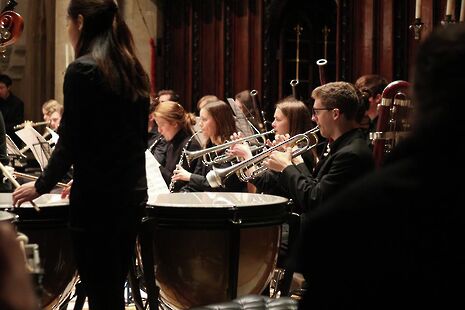Concert review: Mahler’s Symphony No.4
Thea Sands reviews a concert full of contrasts, and wonders how the classical concert can become more diverse

The newly founded Malcolm Street Orchestra, headed by the vivacious Jack Bazalgette, gave an elegant and precise performance of Mahler’s Fourth Symphony. The unusual brevity of the concert was a welcome change, allowing for total immersion in the symphony without the usual lull that comes with a standard two-hour concert. Even with every seat taken, the audience was small and intimate, which made the concert seem personal and easy to engage with.
It must be remembered that this was a full performance of an hour long symphony that is longer than most ‘standard’ four-movement symphonies, performed in the great space of Jesus Chapel. This juxtaposition between small and large, between the space and the audience, echoed throughout the entire piece. Featuring the Concerto Grosso-style (a composition for solo instruments accompanied by an orchestra) effect of Concertante against Ripieno, soloist versus the entire orchestra, the ensemble highlighted Mahler’s intention to create a space for discussion and conflict among the players, which made the work seem almost like a precursor to Benjamin Britten’s A Young Person’s Guide to the Orchestra.
Special credit must be given to the leader of each section, many of whom had a solo and dialogue throughout. These ranged from the soaring heights of Aditya Chander’s violin in the first movement to the snarling, woody tone of the strings in the second movement, which led into a frantic conversation between the leader and another violinist. Woodwind and brass solos flickered into life throughout, with a particularly memorable funeral call from a trumpet in the second movement anticipating the opening trumpet solo of Mahler’s Fifth Symphony.
The bells that rang throughout the chapel were deceiving, with the audience not always able to tell whether they were part of the ensemble or echoes from a distant church. The Soprano Helena Moore provided an antidote to the occasionally warped and toxic harmonies which punctuated the ends of the movements, joyfully mirroring of the finale of Beethoven’s Ninth Symphony. She sang the flying high notes effortlessly whilst still managing to retain elements of the folk-song style. The whole performance was a display of virtuosity from some of the best musicians from the University of Cambridge, with the cheerful conductor Jack Bazalgette keeping everyone wound up like clockwork.
"I felt roused to dance, to let my body respond to the music"
This work is a symphony of contrasts, constantly lulling the audience into sweet melodic reveries which are then thrashed about by the booming of a bass drum or the triumphant rally of the whole orchestra, forcing an abandonment of lyricism and the adoption of brute sound. These contrasts and conflicts led me to question the very nature of the classical concert, and the lack of contrast, conflicts or diversity within the classical music world.
At a Camerata Musica concert at Peterhouse last week, I observed the social hierarchies of a ‘prestigious’ concert. Working as a steward, I was at the bottom of the pile, selling £49 tickets to those wanting to bathe in the glory of Mozart, Janacek and Chopin. The sanctification of ‘classical music’ as a form that must be hailed, that one must remain silent during, that must be respected and looked up to as one of the highest forms of art, is a strange convention.
Classical performances are made distinct, stuck on a pedestal that divides them from jazz, rock, pop and folk gigs, whose audiences are encouraged to cheer and clap between songs. They move, they dance, but when faced with a concert such as Mahler's 4th they become silent and provide a different sort of appreciation. At a classical concert, whooping and cheering during the particularly dramatic parts would be a sign of disrespect. But there were plenty of moments during this concert where I felt roused to dance, to let my body respond to the music. This is division in music, division in culture, division in creativity.
I’m becoming bored with convention. I want a riot. I want diversity. Diversity on stage, diversity in the audience, diversity in the music. Going through the motions of a classical concert is getting dull. Clapping, listening, clapping, cheering, and then leaving with the same demographic of people.
That said, this concert was interesting because it attempted to achieve inclusivity. It shed the £49 price tag of a deluxe evening with the guild of Camerata Musica (it was both free to all and streamed live online). The concert left the packed audience enthused by the power of the music and the power of the performers. It was full of vitality provided by a driven and exuberant group of students who clearly knew what they wanted to do with the music, and was perfect for anyone who wanted to gain insight into the nature of classical music concerts in an environment that didn’t totally reek of privilege and the musty stench of tradition
 News / Cambridge academics stand out in King’s 2026 Honours List2 January 2026
News / Cambridge academics stand out in King’s 2026 Honours List2 January 2026 Interviews / You don’t need to peak at Cambridge, says Robin Harding31 December 2025
Interviews / You don’t need to peak at Cambridge, says Robin Harding31 December 2025 Comment / What happened to men at Cambridge?31 December 2025
Comment / What happened to men at Cambridge?31 December 2025 Features / “It’s a momentary expression of rage”: reforming democracy from Cambridge4 January 2026
Features / “It’s a momentary expression of rage”: reforming democracy from Cambridge4 January 2026 News / Varsity’s biggest stories of 202531 December 2025
News / Varsity’s biggest stories of 202531 December 2025









